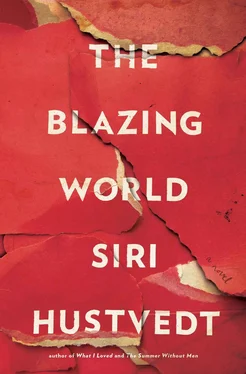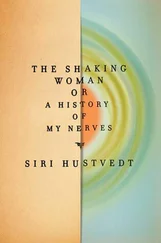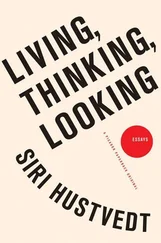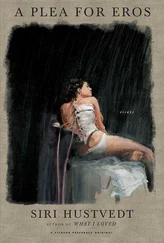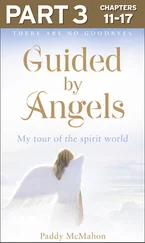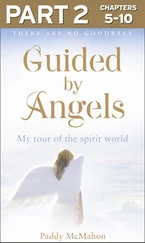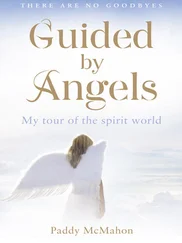When she told me what the scan had found, she was standing, white-faced in the kitchen: I can’t die now. How can I die now, Bruno?
Harry did not want to die.
I learned new terms: epithelial-stromal tumor, debulking surgery, and adjuvant chemotherapy. They debulked her, all right, scooped out as much of the cancer as they could, but it had gone to her liver. She was in stage four of ovarian cancer, for Christ’s sake, a death sentence, but the doctors murmured about procedures that just might possibly extend life expectancy and exceptional cases, although they were rare, very rare, it was true, their eyes averted or looking directly at you to show they weren’t wimps. The chemo made her pale, sick, weak, and dizzy. But the tumors didn’t shrink enough, not enough to save her.
With her fingers dug into her belly or pressed into her temples, Harry thrashed in her hospital bed, the pain blinding her, pain the morphine didn’t dent, and she howled against the fates. Her hollow face, her red eyes leaking tears, her mouth contorted, she cursed the doctors and the nurses and she cursed me, and she cursed whoever else happened to be around, in a voice that blasted like a siren through the ward. My dragon lady came back. Why are you torturing me? And the white and blue coats came running and those in them scolded her about the other patients: They have a right to some peace, too, don’t they? Harry was not the only sick person, after all. Look at Mrs. P., missing a leg, lost to a tumor. She was sicker than Harry, by God! Look at Mrs. P. She behaved herself. Mrs. P. was dying fast. Chastened momentarily and sorry for poor Mrs. P., Harry snuffled in her bed. I don’t want to die.
Harry had let them cut her open. She had let them gut her of all her reproductive organs plus more pieces of herself, had allowed them to sew her up and let her languish in the bed with mostly kind nurses, except one (Thelma). She had let them poison her with chemo and truss her up to IVs and talk down to her as if she were a five-year-old, because she wanted to live. She wanted them to save her, to work miracles on her, to bring her back to her old self. They shouldn’t have laid a goddamned hand on her. That’s what I say, not a goddamned hand. They should have sent her home with a truckload of narcotics and left her alone. Maisie and I disagreed. Maisie and I bickered. Maisie bustled and cleaned up and wiped her mother’s head and cleaned her thighs of errant urine and brought her sandwiches from Zabar’s she couldn’t eat. Let her be, I snapped at her once. Just let her be. Maisie cried. I apologized, and we made it up. Ethan had shell shock, the big-eyed, silent version. He leaned against the wall and watched. Every once in a while he would cross his arms on his chest, grab his upper arms, and rock back and forth.
We set up a hospice at the lodge, but Harry was worse, too weak to put up much of a fight, except now and again — a piercing wail or a gob of spit sent across the room. Sweet Autumn tiptoed in one day with a weird little mutt and a bag of her healing stones and shells and a lot of New Age craziness swirling in her head, and stayed until the end. We would have kicked her out, but Harry liked her. Harry liked her little heart-shaped face with her bright red lips and fairy princess blond curls and her chatter.
This is hard for me to write. These words come hard to me; each one begins as a stone in my mouth. Harry’s pain arrived in bolts that made her limbs stiffen. We turned up the drip. She whimpered as she lay stiffly flat on her back, and she allowed me to stroke her head, her neck, and her shoulders. I’ll be good, she whispered. I promise to be good, Bruno. Don’t leave me. I’m afraid. I told her I wouldn’t leave her, and I didn’t. She left me. Her last word was no . She said it several times, and before she died, she rattled. The noise came from deep in her lungs, shuddering, dry, and loud, and we watched. Harry died at three o’clock in the afternoon on April 18, 2004, with the window wide open in the room so the spring air and sunlight could reach her face.
Damn you, Harry. Damn you, for leaving me too soon.
Timothy Hardwick (“Rune’s Ego Machine: Harbinger of the New Aesthetics” in Visibility: A Magazine of the Arts , February 2009)

Rune’s final work, Houdini Smash , which now exists as both a film and as an architectural relic of the “performance,” calls upon the critic to examine, yet again, questions about the nature of art itself. Arthur Danto persuasively argued that the dominant narrative of Western art came to its end at the moment Warhol created art that was indistinguishable from objects in the supermarket. In the post-Warhol era, Rune’s Houdini Smash figures as a meditation on the idea of beginnings and endings, not only of art, but of the breakdown between the biological and the artificial, categories that are swiftly becoming indistinguishable. We have entered an era of the hybrid bio-robot, an age when scientists are building computational models of the meta-representational structures of consciousness itself. There are many who believe it is a matter of two, perhaps three, decades before the neural correlates of consciousness will be discovered and replicated artificially. The mystery, one long viewed as impossible to penetrate, will be solved. The hard problem of consciousness will go the way of the double helix.
Rune’s Houdini Smash anticipates the birth of the ego machine, a humanly created artistic product that is itself conscious, the arrival of a technology that will radically transform the meaning of creativity because artists will generate art objects that have self-models, that is, they will be able to make aesthetic creatures or robotic offspring who think and act. In an interview he gave in Art Assembly , Rune discussed his fascination with artificial intelligence and its radical potentiality. Citing Vernor Vinge and Ray Kurzweil, he said, “AI is the cutting edge in art, whether people know it or not. It will revolutionize artistic practice by providing artists with tools for works that are animate and intelligent.” Kurzweil articulated his utopian view in the following statement: “As we gradually learn to harness the optimal computing capacity of matter, our intelligence will spread through the universe at (or exceeding) the speed of light, eventually leading to a sublime, universe-wide awakening.” It seems unlikely that Rune endorsed the optimism of a futurist such as Kurzweil.
Although there are those who maintain that Rune intended to die from the drug he ceremoniously ingests in the film, this critic suspects the opposite. Rune planned for his hours of sleep and eventual reawakening to be recorded by multiple cameras as part of the work’s cycle as a homage to his own version of Futurism. In the construction, the artist’s body functions merely as one section, organ, or member of what must be regarded as a larger anatomical machine. The biological body cannot be regarded as distinct from the artificial limbs, digital screens, and collapsing walls and pathways in which that body is enclosed. Borrowing heavily on the work that preceded it — the complex, grand-scale maze installation, Beneath —Rune built a far more compact maze structure that looks as if it has fallen in on itself, has become essentially a ruined fragment of the former work. In the highly praised Beneath , he used the repetition of objects and films, some of which were pointed allusions to the devastation of September 11, to introduce a mournful, lyrical quality to his art for the first time. Houdini Smash , on the other hand, evokes mechanistic delirium, not dissimilar to the effects he garnered in The Banality of Glamour . Rune’s sublime is not Kurzweil’s utopia, but a darker vision of ecstatic metamorphosis, which he articulated in the same Art Assembly interview: “The artist will no longer control his art. It will function independently of the designer, and therefore create exciting and dangerous new zones of interaction.”
Читать дальше
